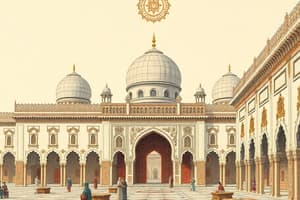Podcast
Questions and Answers
What led to the abandonment of 75% of Bahrain's agricultural land by 1975?
What led to the abandonment of 75% of Bahrain's agricultural land by 1975?
- Increase in population density
- Drying up of groundwater and increased salinity (correct)
- Natural disasters impacting the region
- Government policies on urban development
Which economic activity became secondary in Bahrain after the discovery of oil?
Which economic activity became secondary in Bahrain after the discovery of oil?
- Pearl diving
- Tourism
- Manufacturing
- Fishing (correct)
When was oil first discovered in Bahrain?
When was oil first discovered in Bahrain?
- 1930
- 1934
- 1932 (correct)
- 1936
What percentage of Bahrain's exports does aluminium represent?
What percentage of Bahrain's exports does aluminium represent?
Which company manages the petrochemical industry in Bahrain?
Which company manages the petrochemical industry in Bahrain?
What is the status of Bahrain in the regional financial context?
What is the status of Bahrain in the regional financial context?
Which of the following statements is true regarding Bahrain's gas production?
Which of the following statements is true regarding Bahrain's gas production?
What represents about 12% of Bahrain's non-oil exports?
What represents about 12% of Bahrain's non-oil exports?
What was the backbone of Bahrain's economy until the 1930s?
What was the backbone of Bahrain's economy until the 1930s?
Which factor contributed most significantly to population growth in Bahrain post-1941?
Which factor contributed most significantly to population growth in Bahrain post-1941?
Which Arab tribes migrated to Bahrain after the collapse of the dam in Yemen?
Which Arab tribes migrated to Bahrain after the collapse of the dam in Yemen?
What major shift occurred in Bahrain's economy with the discovery of oil?
What major shift occurred in Bahrain's economy with the discovery of oil?
What was the estimated population of Bahrain in the year 2001?
What was the estimated population of Bahrain in the year 2001?
Before 1941, why were Bahrain's population statistics considered unreliable?
Before 1941, why were Bahrain's population statistics considered unreliable?
Which area in Bahrain was particularly suitable for agriculture?
Which area in Bahrain was particularly suitable for agriculture?
What was the population estimate provided by Captain A. Campbell in 1854?
What was the population estimate provided by Captain A. Campbell in 1854?
Flashcards are hidden until you start studying
Study Notes
Early Settlement and Population Growth
- Evidence of human presence in Bahrain dates back to the Stone Age, found at Aldukhan Hills on the west coast.
- The first recorded civilian human settlement was during the Delmon civilization, located in Barbar and Aldraz in the northern coastal plains.
- Arab tribes like Alazd Alhmeria, Tamim, Abdulqais, and Bakr bin Wael Adnaniya migrated to Bahrain after the collapse of a dam in Yemen.
- From the Islamic period to the 18th century, numerous Arab tribes migrated to Bahrain.
- It's difficult to track population growth accurately before 1941.
- Before the first census in 1941, British authorities relied on estimates to determine the population.
- Population statistics before 1941 were unreliable due to unscientific methods and discrepancies in recorded numbers.
- The most accurate population growth is recorded from 1941 to 2006, showing a significant increase.
Factors Influencing Population Distribution
- The availability of freshwater is a major factor influencing population distribution.
- Arable land suitable for agriculture, found in the northwest, northeast, Sitra, and Muharraq, has also contributed to population concentration.
- The discovery of oil and mining led to the development of Awali and other modern cities.
- The shift from a pearl-based economy to an oil-based economy resulted in increased population in modern urban centers.
- This economic shift also led to the expansion of housing services, healthcare facilities, and educational institutions.
Old Economic Resources
- Pearl Diving: The backbone of Bahrain's economy until the 1930s, generating wealth for centuries.
- Customs Tax: The primary source of government income until the discovery of oil.
- Agriculture:
- Facilitated by freshwater and arable land, the cultivation of date palms had a significant role in Bahrain's economy.
- Agriculture declined in the 1960s due to the drying up of groundwater and increased soil salinity.
- By 1975, about 75% of Bahrain's agricultural land was abandoned.
- Fishing: a traditional economic activity in Bahrain, with a high consumption of fish among the population (23 kg per person annually).
- The discovery of oil diminished the economic dependence on agriculture and fishing.
New Economic Resources
- Oil Production:
- Discovered in 1932 at Jebel Dukhan.
- First oil shipment exported in mid-1934.
- Bahrain's oil production and reserves are smaller compared to other Arab Gulf states.
- Today, it's the primary source of economic income.
- Refining: Unlike other Arab Gulf states, Bahrain exports refined oil instead of crude oil.
- Gas:
- Bahrain has small gas reserves with commercial value.
- Gas production has been increasing steadily in recent years.
Manufacturing
- The discovery of oil led to rapid industrialization and a shift away from traditional industries like pearl diving and shipbuilding.
- Key industries in Bahrain:
- Aluminium: Dominated by Alba, contributing about 13% of Bahrain's exports.
- Petrochemicals: Managed by Gulf Petrochemical Industries Company (GPIC), accounting for roughly 12% of Bahrain's non-oil exports.
- Iron and Steel: Managed by Gulf Industrial Investments Company, with an iron pelletizing plant in Hidd.
Financial Services
- Bahrain is a significant regional financial center for local and foreign institutions in the Arabian Gulf.
- Approximately 395 financial institutions operate in Bahrain.
- The country offers legal facilities for the financial sector.
Studying That Suits You
Use AI to generate personalized quizzes and flashcards to suit your learning preferences.




